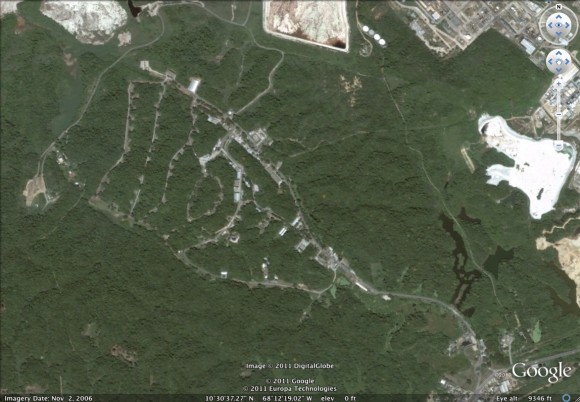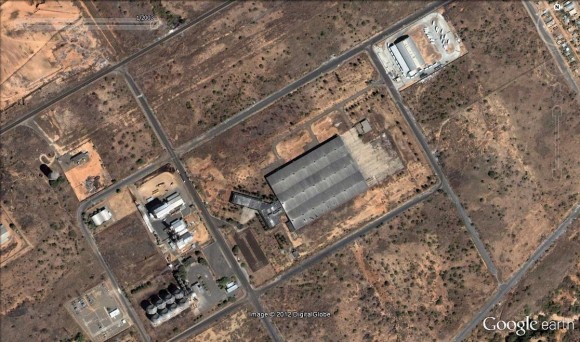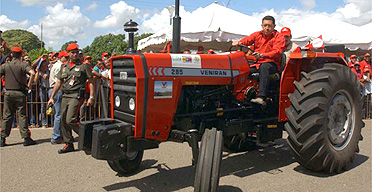Yesterday, I blogged about a pair of Spanish-language news stories that provide new details about Iran’s export of Unmanned Aerial Vehicles (UAVs) to Venezuela. One of the minor details relates to cooperation between the two countries as it relates to explosives. ABC.es reported that Iran had set up an explosives factory with the assistance of a company that made fuel for Iran’s rocket program.
I think the rocket-fuel claim is a bit of a stretch, but there is some explosives cooperation, which is sort of fascinating in and of itself.
1.
Venezuelan President Hugo Chavez, when Iranian President Mahmoud Ahmadinejad visited in September 2006, announced that Iran would help Venezuela build an explosives factory. The wire stories make only brief references to the facility, but Iran and Venezuela signed 29 accords, 5 MOUs, and a Joint Statement — so none of the agreements are mentioned in more than passing.
Yesterday, I mentioned a series of leaked State Department cables (not work safe) about an impending transfer of UAVs from Iran to Venezuela. The cable also described a January 2009 shipment, interdicted in Turkey, of drums of nitrate and sulphite chemicals and dismantled laboratory instruments to Venezuela from Iran. That interdiction was widely reported at the time, which would seem to confirm that Iran and Venezuela had begun to make good on any September 2006 agreement.
The ABC.es story makes clear that the destination would have been CAVIM’s facility near Morón.
2.
CAVIM’s facility near Morón, which is a German-designed facility for handling explosives, is in fact the obvious candidate for an Iranian explosives facility.
That facility is located at: 10°30’24.00″N, 68°12’11.00″W. I assess the location with high confidence. CAVIM’s website has a large number of ground-truth photographs of the facility, including the entrance, the nitric-acid plant, and the explosives-testing area.
The entrance (left image) is a dead ringer (notice the little green sign? That’s a signature of the facility) for the sign at: 10°30’5.96″N, 68°11’41.82″W. The two tall structures at the nitric-acid plant (middle image) appear only as shadows in the satellite images available in Google Earth. (The image in Bing is not better.) Still, the tanks and buildings at 10°30’49.03″N, 68°12’25.21″W match up and there is no ground-truth image that would exclude the site. There is even a nice clearing at 10°30’39.41″N, 68°13’6.76″W in which to blow things up (right image).
What clinched it for me was this description of the location of the facility:
En las instalaciones de Compañía Anónima Venezolana de Industrias Militares en Morón, se elaboran productos químicos y explosivos que son destinados en 98% a la industria nacional y el restante 2% para la militar. Se trata de una enorme instalación militar con siete plantas topográficamente localizadas entre montañas y cerros que sirven de protección y seguridad a sus trabajadores. Su diseño fue realizado con asesoría alemana.
Cavim surgió de la fusión de las instalaciones del antiguo Instituto Venezolano de Petroquímica y el Ministerio de la Defensa. Aún una de sus estructuras está ubicada en las adyacencias del Complejo Pequiven-Morón, cercano también a las empresas Tripoliven y Ferralca.
Allí funcionan las plantas de artificios militares, de agentes de voladura, nitrocelulosa, ácido nítrico, Ansol, servicios básicos, Anfo y Anfoal, según indicó una fuente cercana a la empresa que está ubicada en el kilómetro 1 la carretera Morón-Coro, entrando a la avenida Falcón, en la zona de El Jabillo.
Obviously, the statement that it looks like an explosives handling facility, with buildings separated by hills and mountains, eliminates anything else in the vicinity. So does the description of the location, which notes that it is adjacent to the Pequiven-Morón complex. (Indeed, it was once part of the complex, along with the two industrial enterprises mentioned, Tripoliven and Ferralca.) There are plenty of old maps showing Pequiven-Morón.
Finally, the description resolved the one thing that was holding me back — although the address is listed as 1 Carretera Morón-Coro, the actual entrance is off Avenida Falcon, just before it feeds on to Cr. Morón-Coro. The explanation that the entrance is at the conjunction of the two roads excludes any other facility.
After I went through all this, the municipal website posted a photo and location marker titled “Entrada a Cavim y paso de los rieles.” Now you tell me!
This is probably where those explosives interdicted in Turkey were headed.
3.
There is also some evidence that CAVIM has been involved in explosives exports to Iran. Yep, Venezuela exported explosives to Iran in 2010.
Venezuelan newspaper El Nacional reported that, based on customs data, Venezuela had exported a significant amount of explosives in 2010. I used my schoolboy español to go through the Venezuelan export statistics — it turns out it was 4,556 kilograms of explosives worth $376,527 (1,615,299 in Venezuelan Bolivars). There is so little Iran-Venezuela trade, it was pretty easy to cross-compare codes. I knew that 73 percent of non-oil trade in 2010 was explosives. So I just looked for a ~$375,000 entry in the right customs category, and there it was.
The customs data also included the port of exit, which was very, very interesting.
(A few time-savers if you try this at home: the site doesn’t like Firefox and Iran is filed under R — for the “Republica Islamica de Iran.”)
4.
Another report on the explosives shipment, by Reportero24, used Foreign Ministry documents to indicate that CAVIM used a rather infamous Caracas-Damascus-Tehran flight to export the explosives.
“Oh, come on,” I thought.
Conviasa, Venezuela’s state airline, ran a code share with Iran Air that stopped over in Damascus from 2007-2010. (A direct flight from Caracas to Damascus resumed shortly after the end of the Iran Air code-share.)
The Conviasa-Iran Air code share made people crazy. El Pais wrote the least alarmist narrative, raising concerns about how terrorists might use the flight, after the US picked up one unsavory fellow trying to get to Caracas to make his connection to Tehran. The State Department observed that “Passengers on these flights were reportedly subject to only cursory immigration and customs controls at Simon Bolivar International Airport in Caracas.” Fox News decided to play it classy, going with “Terror Flight.”
Aviation enthusiasts, by the way, provide at least three trip reports on what the flight was like (1, 2, and 3). The best part about the pictures are the passengers giving the photographer the “stink eye” for taking pictures.
Man, it takes real stones to snap pictures on the Caracas-to-Tehran flight.
The port of exit for the explosives was Maiquetia, which is the Simon Bolivar International Airport in Caracas. Well.
The Reportero24 story, by the way, was based on a document recording meetings that the Foreign Ministry submitted to the National Assembly. I didn’t understand why CAVIM would be involving the Foreign Ministry in this effort, until I noticed another little detail reported by El Pais — there was no cargo agreement for the CONVIASA flight, so anything more than baggage traveled as diplomatic pouch. Hence the need to talk to the Foreign Ministry.
Now, I still don’t know why Venezuela declared the value of the export nor why Iran was interested in importing CAVIM’s products.
But one thing I do know: I would have no interest in taking a Caracas-Damascus/Tehran flight laden with explosives.
4.
Because the crates were labeled as “tractor parts,” suspicion has focused not on the explosives facility near Morón, but on a tractor factory near Ciudad Bolivar.
Conspiracy theories abound concerning an Iranian-Venezuela joint venture to manufacture tractors. I wasted more time on this stupid tractor factory than just about anything else. Roger Noriega, in a piece that really should shame the editors at Foreign Policy entitled Chávez’s Secret Nuclear Program, neatly presents the theory that something nefarious is afoot:
Operated since 2006 by a Venezuela-Iran joint venture, the facility produces few tractors and is housed in a military-style compound protected by Venezuelan National Guard troops, according to two eyewitnesses who have visited and videotaped the facility in recent years. Deep suspicions about the actual purpose of that facility were raised in December 2008 when Turkish customs authorities intercepted a shipment sent from Iran to the “tractor factory” in Venezuela.
According to the media reports regarding the 2009 interdiction in Turkey, drums of nitrate and sulphite chemicals and dismantled laboratory instruments were labeled as “tractor parts.” A lot of anti-Chavez sites, thinking they were putting 2 and 2 together, started pointing at the tractor factory like it was the end of the world.
I actually think it’s a tractor factory. Here is an overhead.
The overhead image is from 2003, which predates the agreement to start the joint venture by Khatami and Chavez in 2005. (The facility is apparently named after Khatami.) Veniran took over the facility from a defunct tractor manufacturer called Fanatractor. Still, looking at an exterior shot of the building, I am tentatively able to conclude that it is the correct location.
Obviously the tractor/flag display is of post-2005 vintage, but the shape of the building (dog-legged), location of the parking lot, and road configuration (s-curve) are all consistent with the overhead image from 2003. And the size of the building matches the description of the old Fanatractor facility, as having 20,360 square meters of covered area, including the main assembly hall and a 2,500 square meter administration building.
Also on the side of the “tractor factory” hypothesis, there are a bunch of pictures from inside the factory showing tractor assembly. There also seems to be some indication of labor strife, which strikes me as unlikely for a secret military installation. (Apparently, the Iranians are not progressive employers.)
On the other side of the ledger, Noriega claimed the factory produces “few” tractors and is a “military style compound.” I am not so sure about either claim. The Venezuelan government claims they have assembled 7,500 tractors since 2005, which is well below the original target of 5,000 a year, but hardly a null result. (“Hey, watch where you go with that tractor, compadre, I am trying to mix up some explosives here!”)
The site does not, actually, look like a military-style compound for handling explosives, especially when compared to the CAVIM Morón site which is, you know, a military-style compound for handling explosives.
If Roger Noriega showed up at the VENIRAN site demanding the see the nuclear reactor or explosives laboratory, I am sure security would escort him away — but that doesn’t really tell us anything interesting. If Roger Noriega showed up in my office demanding to see either one, I would call security too.
On the whole, it just looks like an inefficient tractor factory that does a lot of kit assembly of Iranian parts. That’s pathetic, but not particularly siniestro.
The fact that Turkish officials claim the explosives shipment was listed on the manifest as “tractor parts” is an insufficient basis on which to conclude that the parts were bound for VENIRAN, let alone this specific facility. Indeed, were there evidence that VENIRAN was engaged in armaments trade in violation of UNSC 1747, I would have expected it to be sanctioned along with CAVIM and PDSVA. It was not.
If I had to make a guess, the “tractor factory” claim is a red herring.
Not that Chavez doesn’t delight in this. Two reporters in the Guardian described the purpose of the tractor factory rather wittily, noting the facility was “designed to produce three things: tractors, influence, and angst.” (I sometimes see this quote attributed to Fars News, or a “Farsi News Agency,” but I have never seen that attribution accompanied with a citation.)
Mission accomplished.
Update | 2:22 pm
The link showing the little green signs all over the CAVIM facility at Morón is dead, leaving me to wonder if I still have the images saved some place. I’ll keep looking.
In the course of looking around, I discovered that a reporter for Univision, Casto Ocando, posted two images of documents he claims are related to the construction of an Iranian gunpowder factory at Morón, including a document from Parchin Chemical Industries (PCI), a listed entity under UNSC 1737.














Links 2 and 3 re the CCS/DAM flight reports are both the same link by the way
Perhaps its a fiendish plan to produce….NUCLEAR POWERED TRACTORS!!!
just think how environmentally friendly they would be
My tired and slightly addled brain may have goofed, but…
$75 a kilogram??? Did I divide that right?
Them are pretty expensive explosives…
Its a commercial flight, so those are probably checked baggage fees. Those things are a real killer.
Seeing how Iran could reasonably be expected to make as much ANFO as it wants, I’d assume this is a fair price for specialist explosives. I’d also assume that it’s too cheap (and too big a quantity) to be specialist enough that it crosses into the realm of this blog.
Airborne munitions perhaps?
Jeffrey posst excerpted:
<<…ABC.es [ http://www.abc.es/20120611/internacional/abcp-investiga-venta-iran-aviones-20120611.html ]
<<reported that Iran had set up an explosives factory
<<with the assistance of a company that made fuel
<<for Iran’s rocket program.
<<I think the rocket-fuel claim is a bit of a stretch,
<<but there is some explosives cooperation, which is sort
<>
I saw no mention of <> in the linked ABC dot es article, although all Jeffrey’s other aggregated depictions on the source(s’) content appear accurate, as far as I examined those online documents.
Compare to the apparently relevant passage near the start of the linked abc dot es text:
<<La investigación, que lleva casi dos años en marcha y
<<aún no está cerrada, desvela la implicación de algunas
<<de las principales compañías industriales iraníes de
<<defensa, sancionadas internacionalmente por su presunta
<>
School translation:
‘The investigation, which has been underway nearly two years and is not yet ended, reveals involvement of the principal Iranian industrial companies in [the defense sector], internationally sanctioned for their presumed connection to missle programs.’
I am very familiar with the oil refining and petrochemical facilities in Venezuela since 1970.
Suffice to say that I would not lose any sleep and neither should you about explosives made there, or anything else made there. Unfortunately I cannot say more, but all you smart people can read between the lines…